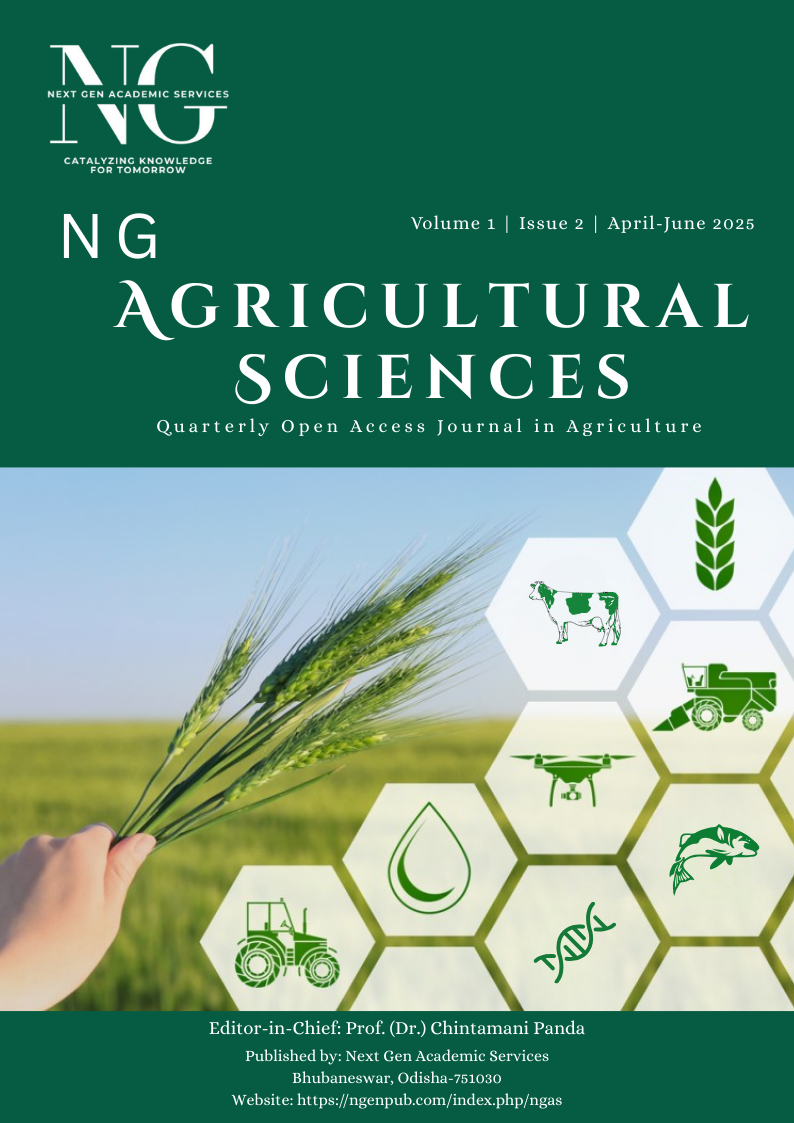Convergence in fisheries extension: bridging gaps for sustainable development
DOI:
https://doi.org/10.5281/zenodo.15305070Keywords:
Capacity Building, Climate Change, Digital Extension, Fisheries Extension, Sustainable DevelopmentAbstract
The Indian economy depends heavily on fisheries because their annual GDP contribution amounts to 1.07% while providing jobs to more than 28 million people. India functions as the third-greatest fish producer worldwide because its fisheries business provides fundamental sustenance for food security and nourishment. The fishing industry experiences severe challenges because of climate change and passive market demands, and decreased available resources. The review inspects fisheries extension services to determine how well they tackle industrial shortcomings while producing sustainable outcomes. Convergence achieves its goal through joint operations between various stakeholders to boost the effectiveness of extension services. An evaluation process determines the joint effects of these approaches through which technology spreads while professionals develop new skills and gain access to markets. This review concludes by suggesting interagency cooperation efforts for better convergence together with increased education possibilities alongside blockchain and AI and IoT platform implementation. These interventions function as the base to increase fish farming capability and maintain a sustainable fisheries industry.
References
Bhaumik, U. (2016). Fisheries extension, its status and strategies for development of inland fisheries in the country. International Conference on Aquatic Resource & Sustainable Management, 66–68.
Christoplos, I. (2010). Mobilizing the potential of rural and agricultural extension. https://www.fao.org/3/i1444e/i1444e00.pdf
Davis, K., Rasheed Sulaiman, V., Cho, K. M., Xia, X., Susumu, G., & Cardenas, V. (2016). Investment in extension and advisory services in Asia-Pacific region: Status and opportunities. In High Level Policy Dialogue on Investment in Agricultural Research for Sustainable Development in Asia and the Pacific (pp. 90). https://www.apaari.org/wp-content/uploads/2021/10/Investment-in-Extension-Asia-Pacific.pdf
De, H. K., Saha, G. S., Srichandan, R., & Vipinkumar, V. P. (2008). New initiatives in fisheries extension. Aquaculture Asia, 13(3), 16–19.
Food and Agriculture Organization (FAO). (2014). The state of world fisheries and aquaculture 2014. Rome: FAO. https://www.fao.org/3/i3720e/i3720e.pdf
Hara, M., & Isaacs, M. (2012). Current state of extension and advisory services in South African fisheries. https://agritrop.cirad.fr/570038/1/document_570038.pdf
Kumaran, M., Ravichandran, P., Panigrahi, A., Sinha, M. K., Nagarajan, S., Vimala, D. D., & Ponniah, A. G. (2012). Effectiveness of sensitisation on the awareness levels of fishery extension officers on Pacific white shrimp (Litopenaeus vannamei) farming in India. Indian Journal of Fisheries, 59(4), 123–129.
Lahiri, B., Anurag, T. S., Marak, B. R., Sangma, A. K., & Sangma, S. M. (2020). Development of mobile-based fishery advisory prototype: An experience with fisher tribes of Garo Hills in North-Eastern Himalayan region of India. Indian Journal of Fisheries, 67(3), 10–17. https://doi.org/10.21077/ijf.2020.67.3.97400-02
Masangano, C. M., Kambewa, D., Bosscher, N., & Fatch, P. (2017). Malawi's experiences with the implementation of pluralistic, demand-driven and decentralised agricultural extension policy. Journal of Agricultural Extension and Rural Development, 9(9), 185–195. https://doi.org/10.5897/JAERD2017.0861
Mishra, S. S., Rakesh, D., Dhiman, M., Choudhary, P., Debbarma, J., Sahoo, S. N., & Mishra, C. K. (2017). Present status of fish disease management in freshwater aquaculture in India: State-of-the-art review. Journal of Aquaculture & Fisheries, 1(003), 14. https://doi.org/10.24966/AAF-5523/100003
Mohanty, A. K. (2022). Advances in extension techniques for the development of fisheries sector. ICAR-CIFT.
Mohanty, A. K., Sajeev, M. V., & Sajesh, V. K. (2020). Innovative extension approaches for sustainable technology dissemination in fisheries. ICAR-Central Institute of Fisheries Technology.
Ojha, S. N. (2017). Fisheries extension and social entrepreneurship. In S. C. Babu & S. Dey (Eds.), Social entrepreneurship in aquaculture (pp. 335–348).
Ojha, S. N., Dey, S., & Babu, S. C. (2020). A bottom-up approach for a private fisheries extension system: A framework and action plan for an aqua-chamber of commerce in India (Vol. 1931). International Food Policy Research Institute. https://doi.org/10.2499/p15738coll2.133697
Omar, S. Z., & Chhachhar, A. R. (2012). A review on the roles of ICT tools towards the development of fishermen. Journal of Basic and Applied Scientific Research, 2(10), 9905–9911.
Pongener, B., & Sharma, A. (2018). Constraints faced by the fishery enterprises: A SWOC analysis. International Journal of Current Microbiology and Applied Sciences, 7(5), 1595–1603. https://doi.org/10.20546/ijcmas.2018.705.192
Qurani, I. Z., Fawzi, N. I., Fadilah, R., & Kismorodati, W. (2021, May). Empowering fish-farmer through coastal field school: Towards sustainable aquaculture practice. In IOP Conference Series: Earth and Environmental Science (Vol. 750, No. 1, p. 012054). IOP Publishing. https://doi.org/10.1088/1755-1315/750/1/012054
Sajesh, V. K., Padaria, R. N., & Sadamate, V. V. (2018). Pluralism in agricultural extension in India: Imperatives and implications. Economic Affairs, 63(4), 1017–1025. https://doi.org/10.30954/0424-2513.4.2018.31
Sajesh, V. K., Suresh, A., Mohanty, A. K., & Sajeev, M. V. (2020). Streamlining fisheries extension. ICAR-Central Institute of Fisheries Technology.
Vipinkumar, V. P. (2018). Establishing fish-based enterprises for livelihood security: Scopes and opportunities.
Viswanathan, N. S., Yadav, M., Sharma, A., & Dornadula, V. H. R. (2023). Marketing strategies of fish and fishery products in India: An empirical study of market intermediaries. Journal of Survey in Fisheries Sciences, 10(3S), 3273–3280. https://pure.jgu.edu.in/id/eprint/5907
Downloads
Published
Issue
Section
License
Copyright (c) 2025 Chinmaya Nanda, Suman Dey, Parnika Saha

This work is licensed under a Creative Commons Attribution 4.0 International License.





